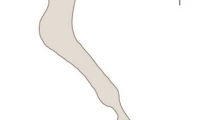Abstract
Seasonal succession of phytoplankton biomass, its diversity and its photosynthetic activity in two highly eutrophic lakes have been compared. In order to test the intermediate disturbance hypothesis, the lakes have been chosen with almost the same level of trophy but different conditions of stratification, through two ice-free periods of open water with different weather conditions.
High phytoplankton diversity throughout the period of investigation was characteristic for the shallower Lake Lobardzu. The number of species here was usually more than 30 and the Shannon diversity changed from 1.2 to 4.2. Owing to the frequent external disturbances, periods characterized by autogenic succession with establishing dominance and declining diversity alternated with periods of biomass reduction and rises of diversity and photosynthetic activity. In the warmer summer of 1983, with more intense warming of bottom layers and predominance of blue-greens, phytoplankton biomass was higher and diversity lower than in the cold summer of 1982.
In stratified Lake Rudusku, phytoplankton diversity and number of species were usually much lower. During the long summer stratification up to three-four dominant species of blue-greens and dinoflagellates become established and competitive exclusion leading to low diversity advanced. Some changes in biomass and diversity, were caused by zooplankton activity.
Similar content being viewed by others
References
Drabkova, V. G. & M. J. Pritkova, (eds), 1988. Izmenenija a structuri ozernich ecosystem v uslovijach uvelichenija biogennoi nagruzki (Changes of lake ecosystems structure in conditions of nutrient loading increase). Nauka Publ. House, Leningrad, 311 pp (in Russian).
Hardin, G., 1960. The competitive exclusion principle. Science 131: 1291–1297.
Hutchinson, G. E., 1961. The paradox of the plankton. Am. Nat. 95: 137–146.
Hindak, F. & I. Trifonova, 1989. Morphology and ecology of three Lymnothrix species (Cyanophyta) from the hypolimnion of a highly eutrophic lake in Latvia. Biologia (Bratislava) 44: 3–11.
Federov, V. D., 1971. Svjaz vidovogo raznoobrazija a phytoplanktona s izmeneniem uslovii mineralnogo pitanija (Relation of phytoplankton diversity to changes in the conditions of mineral nutrieiton). Hydrobiol. J., Kiev 9: 21–24. (in Russian).
Gliwicz, Z. M., 1979. Metalimnic gradients and trophic state of lake epilimnia. Mem. Ist. ital. Idrobiol. 37: 121–143.
Guseva, K. A., 1959. Metodi podscheta phytoplanktona. (Methods of phytoplankton counting). Tr. Inst. Biol. Vodochr. Borok 2: 44–51 (in Russian).
Margalef, R., 1958. Temporal succession and spatial heterogeneity in phytoplankton. In: Perspectives in Marine Biology. Berkeley-Los Angeles: 323–349.
Odum, E. P., 1971. Fundamentals of ecology. Saunders, Philadelphia.
Padisák, J., L. G. Tóth & M. Rajczy, 1988. The role of storms in the summer succession of the phytoplankton community in a shallow lake (Lake Balaton, Hungary). J. Plankton Res. 10: 249–265.
Reynolds, C. S., 1980. Phytoplankton assemblages and their periodicity in stratifying lake systems. Holarctic Ecol. 3: 141–159.
Reynolds, C. S., 1980. The ecology of freshwater phytoplankton. Cambridge University Press, Cambridge, 384 pp.
Reynolds, C. S., 1988. The concept of ecological succession applied to seasonal periodicity of freshwater phytoplankton. Verh. int. Ver. Limnol. 23: 683–691.
Sommer, U., 1986. The periodicity of phytoplankton in Lake Constance (Bodensee) in comparison to other deep lakes of central Europe. In M. Munawar & J. F. Talling (eds), Seasonality of Freshwater Phytoplankton — a Global Perspective. Developments in Hydrobiology 33. Dr W. Junk Publishers, Dordrecht: 1–7. Reprinted from Hydrobiologia 138.
Sommer, U., Z. M. Gliwicz, W. Lampert & A. Duncan, 1986. The PEG-model of seasonal succession of planktonic events in fresh waters. Arch. Hydrobiol. 106: 433–471.
Trifonova I. S., 1986. Sezonnaja i osnovnaja successija ozernogo phytoplanktona (Seasonal and general succession of lake phytoplankton). Hydrobiol. J., Kiev. 23: 21–28 (in Russian).
Trifonova, I. S., 1989. Changes in community structure and productivity of phytoplankton as indicators of lake and reservoir eutrophication. Arch. Hydrobiol. Beih. Ergebn. Idmnol. 33: 363–371.
Trifonova, I. S., 1990. Ecologia i successija ozernogo phytoplanktona (Ecology and succession of lake phytoplankton). Nauka Publ. House, Leningrad. 178 pp (in Russian).
Author information
Authors and Affiliations
Rights and permissions
About this article
Cite this article
Trifonova, I. Seasonal succession of phytoplankton and its diversity in two highly eutrophic lakes with different conditions of stratification. Hydrobiologia 249, 93–100 (1993). https://doi.org/10.1007/BF00008845
Issue Date:
DOI: https://doi.org/10.1007/BF00008845




